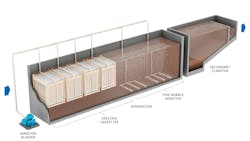Belgian Plant First in Europe to Use ZeeLung Technology
Needing to meet new total nitrogen removal requirements while remaining in its existing footprint, Flanders’ wastewater treatment company, Aquafin, chose to upgrade the Schilde Wastewater Treatment Plant by means of a combined solution of GE's ZeeLung Membrane Aerated Biofilm Reactor (MABR) and ZeeWeed membrane bioreactor (MBR) technologies. The plant, located in the Belgian province of Antwerp, will be the first in Europe to use the new ZeeLung MABR technology.
GE’s Water & Process Technologies offers a hybrid system in which 50% of the wastewater is treated by ZeeWeed 500D MBR, and the remaining flow of 8 million liters per day is treated by a conventional activated sludge system. Adding ZeeLung MABR to the plant will enable improved total nitrogen removal in the conventional activated sludge stream.
The plant was originally designed for the treatment of 28,000 population equivalents (both hydraulic and biologic capacity). The actual load of the Schilde Wastewater Treatment Plant has, however, gradually increased to 35,000 population equivalents. Therefore, in 2015, biological treatment capacity was increased by extending membrane capacity of the MBR (so it can handle more flow) and installing post-denitrification sand filters on the effluent of the conventional activated sludge system.
“Using ZeeLung and ZeeWeed together for the expansion of the Schilde Wastewater Treatment Plant will allow Aquafin to complete the upgrade with minimal modifications and with no need to build new tankage. Additionally, they will be able to meet the new annual total nitrogen removal consent,” said Alain Mineur, CEO, Kamps.
The Schilde Wastewater Treatment Plant is the largest municipal hybrid MBR system in Flanders, and the upgrade is being completed by KAMPS SA. After the expansion is complete in the first quarter of 2017, the plant will have 65% total nitrogen removal.
“Water & Process Technologies’ hybrid solution of ZeeLung and ZeeWeed was about meeting an effluent specification within the plant’s existing footprint. The Schilde Wastewater Treatment Plant needed to be upgraded to increase its nutrient removal ability, and by using ZeeLung, the plant will have lower energy consumption,” said Kevin Cassidy, global leader, engineered systems—GE’s Water & Process Technologies. “The project is the first application of our new ZeeLung technology in Europe.”
ZeeLung MABR technology is a simple solution that allows municipalities to achieve nutrient removal and/or capacity expansion in existing tank volumes while significantly reducing energy consumption. It employs an innovative gas transfer membrane to deliver oxygen to a biofilm that is attached to the membrane surface. Immersing ZeeLung cassettes into mixed liquor increases the inventory of biomass in a treatment system, thereby intensifying the biological treatment process. Oxygen is delivered to the biofilm by diffusion through the membrane, which reduces the energy required for oxygen delivery by up to four times compared to conventional aeration.
Source: GE
